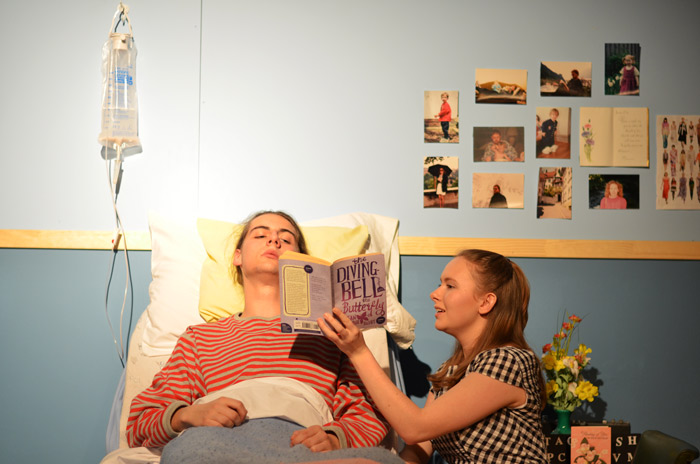The Diving Bell and the Butterfly opens with the beeping of life support, and a comatose figure; right away the audience knows that what follows will be as hard-hitting as it is intimate. Like the novel and film version of the same name, Tuesday Night Café (TNC)’s stage adaptation of The Diving Bell and the Butterfly (1997) depicts the real-life story of Jean-Dominique Bauby (Chris Naccache and Gabe Meacher), a 43-year-old magazine editor-in-chief, who awakes in a hospital bed to discover a stroke paralyzed him from head to toe.
With the help of his good friend Laurence (Ella Storey) and speech therapist Sandrine (Rebecca Bauer), Jean-Dominique weathers revelations both depressing and joyous to write a book chronicling the experience of being “locked-in” his own body, his “Diving Bell.” Somewhat short in length, the play is comprised of interconnected vignettes featuring everything from a hedonistic dream sequence to a wheelchair-bound beach visit, with most of the action taking place within the confines of a cheery hospital room.
Diving Bell’s set thusly consists of a simplistic hospital room backdrop rendered both convincing and unobtrusive, and augmented with tactfully nuanced stage lighting—the silhouette of a window pane on the back wall is an excellent touch of realism. The overall sum of the technicians’ handiwork allows for an unmitigated focus on the characters, with seamless transitioning from scene to scene, and from interaction to interaction. Therefore, character movement through the stage’s space is made to look natural, and like the overall staging, executed with a sharp eye for detail by Director Rachel Stone.
[metaslider id=43175]
In an interesting turn, Bauby is portrayed by two people, who share the stage while alternating between the flesh-and-blood human and “the Butterfly”—a personification of Bauby’s consciousness who narrates verbally what he physically cannot. As such, the interplay between Bauby’s “Diving Bell” and his “Butterfly” often gives the intriguing impression of ventriloquism, though it is sometimes made unclear where the audience is intended to give focus. Nevertheless, the duo is surprisingly adept at packing a plethora of emotional subtext into a literal blink of the eye.
Performances by the rest of the cast are well rounded and, thankfully, avoid overly dramatic flourishes that might cheapen the performance. Appearances by Jean-Dominique’s brash, uppity father (Nic Turcotte) provide a believable humanity and comic relief to balance out the play’s harsher moments, while Bauer’s presence as Sandrine is noteworthy in its infectiously genuine optimism. In Bauby’s interactions with these characters, one finds the palpable tension of a yearning towards mutual understanding that is painstakingly developed letter by letter, word by word, tear by tear. It is unfortunate that the play’s shorter length makes Bauby’s journey feel a bit rushed, and the aforementioned interactions seem to lack the necessary time to develop fully.
There is really nothing quite like a quadriplegia-centric story to make an audience members realize how easy their own lives are in comparison. Thanks to competent technicians, solid directorship, and a stellar cast, TNC’s The Diving Bell and the Butterfly does not quite stop at such compulsory self-appreciation. Instead, it succeeds in serving as a sort of poignant love letter to the healing grace of human connection. People are social beings; the human mind, as demonstrated in the play, seems to produce its most beautiful machinations when it wants to be heard and, most importantly, understood.
TNC’s The Diving Bell and the Butterfly runs from Feb. 3 to Feb. 6 and Feb. 10–13 at 8:00 p.m. in Morris Hall (3485 Rue McTavish). Tickets are $10 for adults, and $6 for students and seniors.








Well done to the author. A valuable post. May I ask you to contact us so that we can talk? Can I write to you directly?